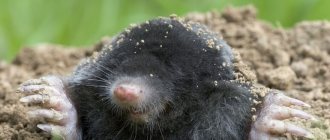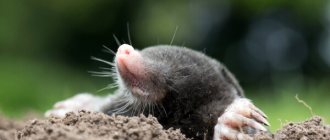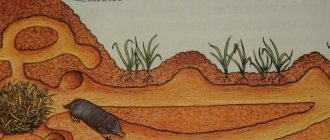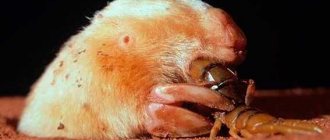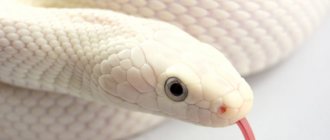Starfish
Known under the names star-nosed mole, star-nosed mole, star-nosed mole, star-nosed mole. In appearance it is similar to most other moles, but differs in its elongated tail (6–8 cm) and hard fur that does not get wet. There are two skin growths on the face, similar in appearance to an asterisk, which is where the name of the individuals comes from. Animals in adulthood weigh up to 85 g. The eyes are small, but clearly distinguishable in appearance. Lives in the eastern regions of North America.
Western American
The body length of the animal is 11–14 cm, while the tail can take up to 5.5 cm. Body weight reaches 170 grams. The proboscis of the muzzle is moderately elongated. The eyes are small, hidden under the fur. There is no external auricle. The hand of the foot is very wide. The tail is thick, covered with sparse hairs. Distributed in North America.
A small species of the Mole family. Lives in China.
Long-tailed
Lives in Asia. Body length 7–9 cm, weight up to 12 grams. There are no auricles. The front legs are slightly widened and equipped with almost straight claws.
Distributed in the Chinese province of Sichuan. It lives mainly in forests of the temperate zone.
Caucasian
Outwardly, it almost completely resembles a European mole. It stands out only for its rudimentary eyes covered with thin skin. It has large teeth and velvety fur. It can burrow to a depth of 1 m. It eats up to 40 g of food per day.
Blind
The smallest mole in our country with a body length of 8–12 cm, weight – no more than 30 grams. The eyes are covered with thin skin. Tail length is about 3 cm.
Japanese mogera
It lives in the southern territories of Japan, as well as in China, Korea and the south of Primorsky Krai. Prefers to live in cultivated fields and meadows.
Appearance and features
Photo: Animal mole
The main feature of these small animals is the lack of vision. If for humans and other animals the lack of vision is a serious defect, then for moles it is considered the norm and even a necessity. Having normal eyes, these animals simply would not be able to spend almost their entire lives underground. Moles have eyes, but in most species they are additionally protected by a layer of skin.
Not only the organs of vision are completely adapted to underground life. The hearing organs are also adapted to it. Moles do not have ears. This is also not just provided by nature. If there were ears, then too high pressure would form in them. Such pressure would not allow the animal to be in the soil.
Diggers have fur that is very pleasant to the touch. It also has some features that differ from the fur of other animals. The mole fur covering can be easily folded in different directions. This property allows animals to slip into narrow underground tunnels without problems. The color of the fur is usually black, brown or dark gray.
The appearance of moles can be characterized by the following parameters:
- The total length of the animal is about sixteen centimeters. Of this, the body occupies approximately seven centimeters, and the rest is the length of the head and tail.
- The average weight of the animal is fifteen grams. However, representatives of the family of larger sizes are known. For example, scientists came across the Ussuri mogera, whose length is twenty-one centimeters.
- The body shape of this mammal is bar-shaped. Moles have a tiny head and an almost invisible neck. The auricles of most members of the family are undeveloped, while in others they are very small and covered with hair. Animals also have a nose in the form of a small proboscis. It contains sensitive hairs. The nostrils are directed forward.
- The mammal's paws have five toes. They are the main tool for digging long tunnels. The paws are strong and have claws. The hands resemble shovels; they are turned with the palms facing outward. The mole digs tunnels with its front legs, while its hind legs are less strong. They are very thin and resemble the paws of rats.
Description of the animal
Its cylindrical, shortened, dense body helps it move through dug tunnels. It is slightly pointed at the front and rounded at the back.
The front part is much better developed. The animal has 6 main species and 11 different varieties. They differ in the structure of the jaw, skeleton, their weight, and size.
Young individuals differ from older mammals in the silvery hue of their skin. The mole has practically no neck. The head seems pulled into the shoulders.
The body smoothly touches the triangular head. On the head there is a proboscis, along the edges of which there are vibrissae. Thanks to these sensitive hairs, the animal finds food.
The mole's forelimbs are wide, everted, and shaped like a shovel. Initially the paws are silver-black. Over time they begin to fade.
There are 5 tightly pressed toes on the feet. They are connected by thin membranes. The claws are elongated, strong, slightly flattened. They reach 10 mm in length.
The hind feet are unwebbed, but with very sharp, elongated claws. The animal has 44 teeth, 2 of which are well-developed upper canines. In adult moles, the fangs are severely worn out.
The size of a male mole from proboscis to tail can reach 115-200 mm, females - from 105 to 145 mm. The weight of males is 90-100 g, females - 60-80 g.
What is the difference between a mole and a mole rat?
- Animals belong to different orders: moles belong to the order of insectivores, mole rats belong to the order of rodents.
- Moles are carnivorous and feed mainly on invertebrates (earthworms, beetle larvae). Mole rats eat underground parts of plants: roots, tubers, bulbs.
- Mole rats dig the ground with large incisors and push it to the surface with their heads. Moles dig and push out soil with their front paws.
- Mole rats are larger than moles: their body sizes vary from 13 to 35 cm, and their weight can reach 700 g. The largest mole, the greater mogera, weighs 300 g and reaches a length of 21 cm.
- The fur of moles is painted in dark colors: black, dark brown, dark gray and their variations. Mole rats are much lighter in color. Their color is dominated by gray, yellowish, brownish and ocher tones.
- Moles have a small tail, ranging from 2 to 10 cm in length. In mole rats, the tail is vestigial and not noticeable from the outside.
- Moles are not blind, unlike mole rats. They see, although poorly. Moles have small eyes, but are covered by skin only in some species. The eyeballs of mole rats are large, but are always located under the skin.
- The habitat of moles is wider geographically: moles live in Eurasia and North America, and gravitate towards forest or forest-steppe zones. Mole rats live in the southern and eastern regions of Europe and Western Asia, preferring steppes, deserts and semi-deserts, and sometimes forest-steppe.
Natural enemies
Moles have relatively few enemies as such. The powerful smell protects them from foxes. They are only suitable for food for badgers. Sometimes dogs and cats hunt animals, but not to kill them, but out of “sporting interest.”
Pets can control the number of moles in their garden. In those households where dogs and cats live, there are almost no moles.
Russian species of moles
There are 4 species of moles living on our territory. For example:
- Common or European mole (Talpa europaea).
- Siberian or Altai mole (Talpa altaica).
- Blind mole (Talpa caeca).
- Caucasian mole (Talpa caucasica).
In addition to these species of true moles, in the Far East there are two more species of this family, which represent the genus Mohera: Mohera greater or Ussuri and Mohera Japanese. Moles and mogers live underground, so they have similarities due to the same lifestyle and diet. They differ only in the color of their body, which in mogeras is brownish-brown. As for other differences, only specialists know about them. If you see animals in photographs, even external differences are difficult to distinguish. Look at the photo of the mole and mogera below.
General characteristics of the appearance of the mole family:
- The body is elongated, covered with short hair, and cylindrical in shape.
- The forelimbs are in the form of shovels, armed with powerful claws.
- The claws are strong and flat.
- The hind limbs are much less developed.
- The skull is small in size and has a cone-shaped shape.
- The mole's nose looks like a small proboscis.
- All moles have underdeveloped eyes, and in some species they are covered with a kind of film.
Different species of moles have different numbers of teeth in their mouths, which is the main feature by which the type of animal can be determined.
All moles are distinguished by the fact that their fur grows straight upward, which does not prevent the animal from moving forward/backward through its tunnels. Therefore, the wool can be laid in any direction.
European or common mole
The habitat of this amazing animal extends over almost all of Eurasia. At the same time, the northern borders pass through the taiga, and the southern borders through the forest-steppe. The western borders are the Atlantic Ocean, and the eastern borders are the Lena River basin.
General characteristics:
- This animal is about 15 cm long with a short tail of about 3 cm.
- The maximum weight of the animal is a little more than 100 grams.
- The European mole has eyes up to 1 mm in size.
- Its color is matte black, with the fur on its belly being a lighter shade. In young individuals the coloring is duller.
Altai or Siberian mole
This representative of the mole family has clearly expressed sexual dimorphism, compared to the common mole.
- Females grow up to a maximum length of 17 cm with a weight of up to 145 g, while males are more massive in size, growing in length to almost 20 cm and gaining weight of more than 200 grams.
- This species has better developed eyes and even has movable eyelids.
- The color is plain, in lead-gray tones or black with a brown tint. At the same time, individuals living in mountainous areas have a darker color, and gray shades are more characteristic of representatives of moles living in flat areas.
This species lives in the vastness of the western and middle parts of Siberia.
Blind or small mole
The smallest representative of moles that lives on our territory. The animal grows to a maximum length of 12 cm, has a short tail, no more than 3 cm long and weighs only 30 grams. It differs in that it has no eyes and is black or dark brown in color.
The main habitat is located in the Caucasus. The animal's diet includes beetle larvae and other food items of animal origin.
Caucasian mole
It has an external resemblance to the common mole, but also has no eyes. It grows up to 15 cm in length and has a tail about 2 and a half cm long or a little more. The animal weighs about 80 grams. It is distinguished by its purely black fur color.
The habitat is limited to the Caucasus Range and the surrounding area.
Wildlife: mole
Watch this video on YouTube
Reproduction
Sometimes moles break their solitary lifestyle to mate. Immediately after its completion, the male leaves the female. He does not help build nests for his young and does not participate in their upbringing. During the breeding season, females show increased aggressiveness towards individuals of their own sex.
Usually there is no more than one brood per year. The gestation period varies depending on the species from 30 (common moles) to 42 days (Eastern moles).
A new generation is born in nests. A brood consists of two to seven individuals. Initially they are naked and hairless, but after two weeks they become overgrown with fur. At three weeks of age, their eyes open. In the first month, babies' nutrition consists only of mother's milk. On the 35th day, moles leave their native nest and begin to look for a free area for themselves. During this period, many of them die under the wheels of cars or from predators.
Nutrition
Females are caring mothers who carefully look after their cubs. Initially, mole babies feed on milk, quickly gain weight, and develop. In about a month, teeth grow, claws grow, the cubs switch to solid food - grain, seeds, roots, insects, earthworms.
At the age of 1.5-2 months, the cubs become independent and are capable of killing a mouse, frog, or snake. The matured young animals behave aggressively towards each other; after 60 days of their existence, each of them begins to build their own burrow with numerous labyrinths.
Baby's diet
During the day, the animal plows about 45 m of soil with its paws. Eats in one day an amount of food equal to its own weight. Constantly in search of food, makes numerous reserves. By the number of hillocks with a mound of soil above the ground, you can determine the trajectory of the burrow.
The baby mole feeds several times a day. Food is digested in approximately 5 hours. Between breaks in food, the animal sleeps in a special “room” curled up in a ball.
Occasionally they eat vertebrates that are in a sedentary state - mice, lizards, snakes, frogs. In a hungry state, an animal can live no more than 17 hours.
Number and economic importance
Moles are ubiquitous and are not a protected species. This is one of the few insectivores that was important as a fur-bearing species. Since the 19th century durable, velvety moleskins were mined in large quantities. Currently, for economic reasons, the mole has almost no commercial significance.
Moles bring benefits by exterminating harmful insects and changing the structure of the soil - loosening it and enriching it with organic matter. Long-term digging activity of moles leads to improved soil; Excess moisture goes through molehills to lower soil horizons. At the same time, the mole is considered a pest of agriculture, gardening and horticulture. Digging its passages, it damages the roots of plants, thereby disrupting their normal nutrition and often causing death. Moles also destroy earthworms that are beneficial to the soil. They fight moles with a wide variety of methods, including using pungent odors (by placing chopped onions, garlic, rags soaked in kerosene, etc.) or sound signals (turntables, reeds, ultrasonic devices, etc.) in the mole passages.
Reproduction and lifespan
Moles, in a sense, are hermits leading a solitary lifestyle. They pair up only during the rutting season, when they mate for a short period of time.
Mating of males and females occurs once a year - in early spring. However, there are exceptions, for example, in Belarus, females manage to give birth twice during the year.
Fertilized females bear offspring for 35-42 days. The average litter consists of 6 cubs, but sometimes up to 9 can be born. Only the female builds the nest for the brood. Babies are born completely naked and blind.
Intensive feeding of young animals continues for 5-8 weeks. Only the female provides food for the cubs; the male does not take any part in feeding and raising the offspring.
By about two months of age, young animals begin to show increased aggression towards their relatives. During this period, the cubs leave the parental nest, and each of them digs its own system of passages, moving on to an independent lifestyle.
Mass settlement of young moles occurs in July-August. This process takes place very quickly; within a day, a young mole can be 700 meters away from the birth nest. Young animals reach sexual maturity in 6-12 months. Next spring, the young are ready to mate and reproduce.
Attention! Moles in the natural environment, under normal living conditions, live from 4 to 6 years.
Mature offspring
At 1.5 – 2 months the baby mole becomes an adult. It can kill mice, frogs, snakes. Mature individuals are aggressive towards each other. On the 35th day they can leave the nest in search of a new home. At this moment, animals often die from attacks by predators or are hit by cars.
At 2 months they build a separate burrow with numerous labyrinths. The animal is capable of plowing up to 45 m of land in a day. The volume of the daily diet is equal to its own weight. The mole is looking for food to stockpile.
The pest eats several times a day. The digestion process takes up to 5 hours. He sleeps between meals. The diet consists of:
- worms;
- caterpillars;
- woodlice;
- larvae;
- slugs;
- snails;
- mole cricket;
- spiders;
- centipedes.
Natural enemies of moles include cats, dogs, foxes, wolves, and hedgehogs.
Where do they live and what is their lifestyle?
Moles can settle in a summer cottage, but this is not their only habitat. In the wild, you can meet these animals in forest areas, as well as near places where people live:
- in the meadows;
- in the gardens;
- on the territory of parks;
- in other green spaces.
Moles prefer to dig holes in moist soil. If it is dry, it will make it difficult for them to dig tunnels. Therefore, they prefer to live in lowlands. Moles feed on earthworms, as well as other invertebrates that live in the soil. It feeds:
- root vegetables;
- grains;
- eat parts of plants;
- earthworms;
- insect larvae;
- centipedes, woodlice.
The largest portion of the diet of these animals consists of earthworms. This is explained by the fact that they are numerous and live everywhere. It can be argued that the mole, while moving through its underground passages, does not neglect any food that comes across its path.
Moles living in the forest feed not only on plants and insects living in the ground, but also on flies, wasps, ants, and insect larvae that they can find.
These animals also prey on mice or small snakes. Almost any creature that wanders into its hole can become its victim. The weight of food that one animal eats is equal to its own weight.
Reproduction
Reproduction occurs starting from March-April. Pregnancy is 40 days. One brood can contain up to 9 cubs.
The lifestyle of these animals is sedentary, but after their birth, young moles move up to 4 km from the place of birth. Their life expectancy is up to 5 years.
Arrangement of the nest
The female builds a nest for the future offspring away from the “spouse’s” burrows. The new mole hole is located at a depth of one and a half to two meters and consists of numerous radial and circular passages. The new dwelling communicates with the old circular gallery of holes.
To protect children from the possible danger of attack and to provide an escape route, the nest is built at the intersection of several underground passages. The nests look like small closets covered with soft grass, leaves or moss.
The habitat area of an adult mole is about 50 hectares. A brood can occupy an area of up to 1250 hectares. To avoid encroachment on its territory, it is marked with a special secretion accumulated on the belly fur. An area not marked with a secret is considered free for settlement.
In search of a comfortable place to live, moles constantly move from place to place. During floods, they move to higher ground, and as the heat sets in, they move to cooler lowlands. In hot weather, moles can go a considerable distance from the house in search of water. At the same time, throughout their lives, they remain in the area of their site.
A friendly neighborhood is not accepted among moles. If a mole living nearby dies or gets caught in a trap, the neighbors immediately notice and expropriate its territory.
Moles and man
Moles are not only unique, but also useful animals that are constantly engaged in destroying various plant pests, and also loosen the soil, due to which it is saturated with oxygen and becomes more fertile. Unfortunately, when the number of moles on a site begins to increase, their benefit begins to turn into harm, since they will dig up not only flower beds or beds, but also paths. In addition, the systematic destruction of earthworms by moles leads to the opposite effect, since soil fertility decreases. If a group of moles settles on a personal plot, then discomfort is guaranteed, since it is very unpleasant to find traces of the vital activity of moles on your plot every day, in the form of molehills, which are low tubercles of freshly dug earth.
Nowadays, there are many ways, including humane ones, that allow you to expel or prevent such animals from entering your area that can cause harm.
Many gardeners use traditional methods, which are the most gentle on animals. Specialists have also developed devices based on electronic components that generate ultrasound, which negatively affects the life of many animals, rodents, and moles. Due to the fact that the animals have a highly developed sense of smell, they cannot tolerate strong odors, as they disorient the animals. As a rule, animals try to leave the area of influence of such components, which create uncomfortable living conditions.
In addition to their sense of smell, moles have very acute hearing, so they can be disoriented by loud sounds or vibration. If loud noises are constantly present in the area, which is not difficult to organize, just take a few cans and secure them on a stick, sticking it into the ground. Under the influence of the wind, they will make not very pleasant sounds, which on a stick will be transmitted into the thickness of the earth. It is unlikely that moles will be able to stay in such an area for long. Although it must be taken into account that such sounds can disturb not only moles, but also neighbors, as well as their family members.
The most effective, although costly, method is the presence of mechanical obstacles dug into the ground along the perimeter of the site. To do this, you can use pieces of slate or metal gratings. They should be dug to a depth of 0.8 meters and no less. Apart from moles or rodents, such obstacles will not bother anyone else.
Star-nosed mole or star-nosed mole (National Geographic)
Watch this video on YouTube
Read about Feeding a mole after birth on Vetatlas.ru
Feeding the mole after birth
Like many other living things, newborn moles are helpless when they first come into this world. At first they have no vision and no fur. Baby moles live with their mothers for one month after their birth, feeding on her milk.
Due to the fact that moles are wild animals that are completely isolated from everything above ground, you should immediately call a wildlife specialist to take the mole to a protected area. However, you will have to keep the mole alive and warm until a wildlife specialist can remove it from you.
Thus, feeding newborn moles is extremely important.
Instructions
Step 1
Purchase newborn mammal formula from a pet store . Suitable brands are KMR powder, Multi-milk, VPL Nurturall milk replacer powder.
Step 2
Prepare mixture according to package directions in a small bowl. Make sure you mix it with water at room temperature or body temperature.
Step 3
Insert the pipettes into the solution and let it suck the milk. Hold the mole with your other hand. Bring the pipette closer to the mole's mouth. At this point, some moles instinctively open their mouths.
Step 4
Gently open the mole's mouth using the thumb of the hand holding it. Insert the tip of the pipette into his mouth. Squeeze the rubber end of the pipette and pour the contents into the mole's mouth.
Step 5
Remove the dropper from the mole's mouth and close its mouth. He will swallow all the milk.
Step 6
Give your mole 2 full servings of milk from a dropper per 113 grams of body weight, every two to three hours, unless otherwise indicated on the package.
2017-03-22
2017-06-19
Vetatlas
st. Academician Koroleva, building 3
Like many other living things, newborn moles are helpless when they first come into this world. At first they have no vision and no fur. Baby moles live with their mothers for one month after their birth, feeding on her milk.
Due to the fact that moles are wild animals that are completely isolated from everything above ground, you should immediately call a wildlife specialist to take the mole to a protected area. However, you will have to keep the mole alive and warm until a wildlife specialist can remove it from you.
Thus, feeding newborn moles is extremely important.
Instructions
Step 1
Buy Newborn Mammal Formula from . Suitable brands are KMR powder, Multi-milk, VPL Nurturall milk replacer powder.
Step 2
Prepare mixture according to package directions in a small bowl. Make sure you mix it with water at room temperature or body temperature.
Step 3
Insert the pipettes into the solution and let it suck the milk. Hold the mole with your other hand. Bring the pipette closer to the mole's mouth. At this point, some moles instinctively open their mouths.
Step 4
Gently open the mole's mouth using the thumb of the hand holding it. Insert the tip of the pipette into his mouth. Squeeze the rubber end of the pipette and pour the contents into the mole's mouth.
Step 5
Remove the dropper from the mole's mouth and close its mouth. He will swallow all the milk.
Step 6
Give your mole 2 full servings of milk from a dropper per 113 grams of body weight, every two to three hours, unless otherwise indicated on the package.
Source: https://vetatlas.ru/articles/rybki-pticy-gryzuny-ekzotika/rybki-pticy-gryzuny-ekzotika–rizne/kormlenie-krota-posle-rozhdeniya/


